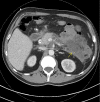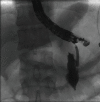Management of pancreatic fluid collections
- PMID: 35548474
- PMCID: PMC9081921
- DOI: 10.21037/tgh-2020-06
Management of pancreatic fluid collections
Abstract
Pancreatic fluid collections often develop as a complication of acute pancreatitis but can be seen in a variety of conditions including chronic pancreatitis, trauma, malignancy or post-operatively. It is important to classify a pancreatic fluid collection in order to optimize treatment strategies and management. Most interventions are targeted towards the management of delayed complications of pancreatitis, including pancreatic pseudocysts and walled-off necrosis (WON), which often develop days to weeks after the initial episode of pancreatitis. Surgical, percutaneous, and endoscopic interventions are all possible methods for treatment of pancreatic fluid collections, however endoscopic drainage with endoscopic ultrasound has become first-line. Advances within endoscopic drainage strategies have also led to innovative changes in the specific stents used for treatment, with possible options including double pigtail plastic stents, fully covered self-expanding metal stents and lumen-apposing metal stents (LAMS).
Keywords: Drainage; pancreatic fluid collection; pancreatitis; stents; walled-off necrosis (WON).
2022 Translational Gastroenterology and Hepatology. All rights reserved.
Conflict of interest statement
Conflicts of Interest: All authors have completed the ICMJE uniform disclosure form (available at https://tgh.amegroups.com/article/view/10.21037/tgh-2020-06/coif). The series “Innovation in Endoscopy” was commissioned by the editorial office without any funding or sponsorship. All authors have no other conflicts of interest to declare.
Figures





















Similar articles
-
Increased Incidence of Pseudoaneurysm Bleeding With Lumen-Apposing Metal Stents Compared to Double-Pigtail Plastic Stents in Patients With Peripancreatic Fluid Collections.Clin Gastroenterol Hepatol. 2018 Sep;16(9):1521-1528. doi: 10.1016/j.cgh.2018.02.021. Epub 2018 Feb 21. Clin Gastroenterol Hepatol. 2018. PMID: 29474970 Free PMC article.
-
Lumen-apposing metal stents in management of pancreatic fluid collections: The nobody's land of removal timing.Saudi J Gastroenterol. 2019 Nov-Dec;25(6):335-340. doi: 10.4103/sjg.SJG_166_19. Saudi J Gastroenterol. 2019. PMID: 31823862 Free PMC article. Review.
-
American Gastroenterological Association Clinical Practice Update: Management of Pancreatic Necrosis.Gastroenterology. 2020 Jan;158(1):67-75.e1. doi: 10.1053/j.gastro.2019.07.064. Epub 2019 Aug 31. Gastroenterology. 2020. PMID: 31479658 Review.
-
Management of Inflammatory Fluid Collections and Walled-Off Pancreatic Necrosis.Curr Treat Options Gastroenterol. 2017 Dec;15(4):576-586. doi: 10.1007/s11938-017-0161-z. Curr Treat Options Gastroenterol. 2017. PMID: 29103188 Review.
-
Outcomes and Post-removal Course of Lumen-Apposing Metal Stent Placement for Peripancreatic Fluid Collections: A Comparative Study of Pancreatic Pseudocysts and Walled-Off Necrosis.Cureus. 2024 Oct 15;16(10):e71561. doi: 10.7759/cureus.71561. eCollection 2024 Oct. Cureus. 2024. PMID: 39553082 Free PMC article.
Cited by
-
Practical approach to acute pancreatitis: from diagnosis to the management of complications.Intern Emerg Med. 2024 Nov;19(8):2091-2104. doi: 10.1007/s11739-024-03666-9. Epub 2024 Jun 8. Intern Emerg Med. 2024. PMID: 38850357 Review.
-
Early endoscopic management of an infected acute necrotic collection misdiagnosed as a pancreatic pseudocyst: A case report.World J Gastrointest Surg. 2024 Feb 27;16(2):609-615. doi: 10.4240/wjgs.v16.i2.609. World J Gastrointest Surg. 2024. PMID: 38463375 Free PMC article.
-
CLINICAL, DIAGNOSTIC AND THERAPEUTIC CHARACTERIZATION OF PATIENTS WITH PANCREATIC COLLECTIONS DUE TO ACUTE PANCREATITIS IN A REFERRAL HOSPITAL.Arq Gastroenterol. 2025 Jul 21;62:e24105. doi: 10.1590/S0004-2803.24612024-105. eCollection 2025. Arq Gastroenterol. 2025. PMID: 40699042 Free PMC article.
-
Management of Postoperative Pancreatic Fluid Collection and Role of Endoscopy: A Case Series and Review of the Literature.Diagnostics (Basel). 2025 May 15;15(10):1258. doi: 10.3390/diagnostics15101258. Diagnostics (Basel). 2025. PMID: 40428251 Free PMC article.
-
Association between acute peripancreatic fluid collections and early readmission in acute pancreatitis: A propensity-matched analysis.World J Exp Med. 2024 Jun 20;14(2):92052. doi: 10.5493/wjem.v14.i2.92052. eCollection 2024 Jun 20. World J Exp Med. 2024. PMID: 38948418 Free PMC article.
References
Publication types
LinkOut - more resources
Full Text Sources
